
Liquid crystals
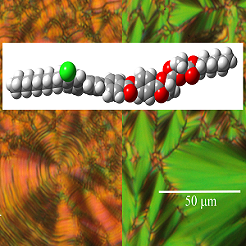
Ferroelectric and antiferroelectric phases in liquid crystalline compounds with terphenyl in the molecular coere
We designed a new type of antiferroelectric liquid crystalline structure with terphenyl in the molecular core and two lactate units attached to the chiral chain [J. Mol. Liq. 336, 116267 (2021)].
For the series of compounds, we studied the mesomorphic properties by various experimental techniques and confirmed the phase identification by x-ray measurements. For selected homologues we proved the antiferroelectric phase with orthoconic properties existing in a wide temperature interval including the room temperatures. Valuable optical properties with the tilt angle about 45 degrees promised a big potential for applications.
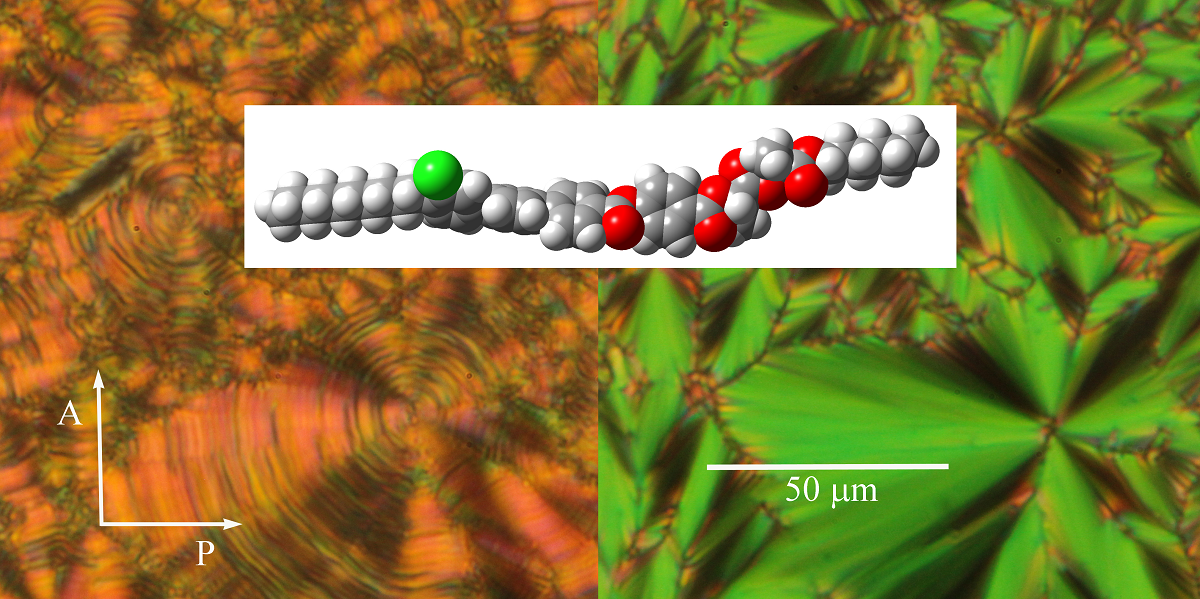
Figure: Texture of the liquid crystalline compound with a terphenyl in the molecular core in antiferroelectric phase without field (left picture) and under applied electric field (right picture). The scale, orientation of polariser (P) and analyser (A) are presented. In the centre, there is a model of the studied molecule in the optimised conformation.
[1] N. Podoliak, M. Cigl, V. Hamplová, D. Pociecha, and V. Novotná, Multichiral liquid crystals based on terphenyl core laterally substituted by chlorine atom, J. Mol. Liq. 336, 116267 (2021).
(show less)
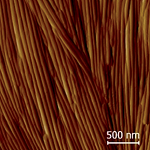
Organic nanotubes created from mesogenic lactic acid derivatives
We found a facile route how to prepare nanotubes from rod-like mesogens dissolved in typical organic solvents. For selected types of chiral rod-like molecules, both enantiomers as well as the racemic mixtures, the nanotubes are formed by slow evaporation from a solution, regardless the solvent, concentration or deposition type. Obtained supramolecular assemblies were studied using various experimental techniques and nanotubes of 50-60 nm diameter described. We proposed rolling-up mechanism related to the surface tension difference at the opposite layer surfaces.
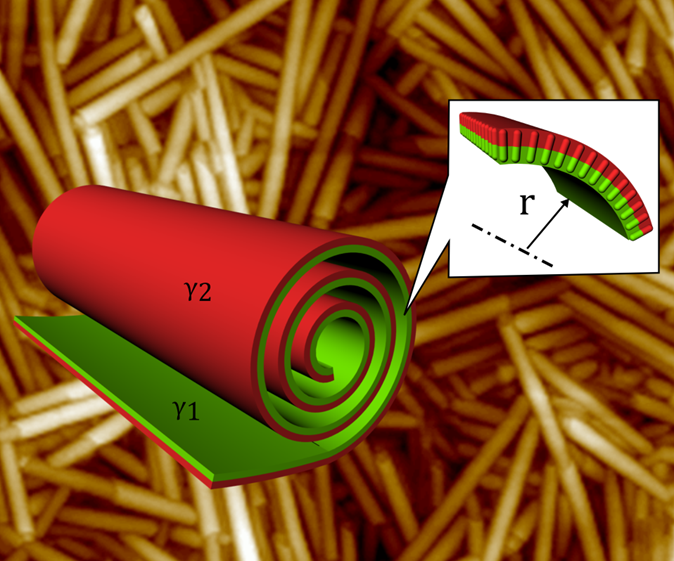
Figure: In the background AFM picture shows nanotubes, the diameter of observed nanotubes is 50-60 nm. A scrolling-up mechanism of crystalline molecular layers was proposed based on difference between the surface tension at the opposite surfaces.
[1] V. Novotná, V. Hamplová, L. Lejček, D. Pociecha, M. Cigl, L. Fekete, M. Glogarová, L. Bednárová, P. Majewski, E. Gorecka. Organic nanotubes created from mesogenic derivatives Nanoscale Adv. 1, 2835(2019).
(show less)
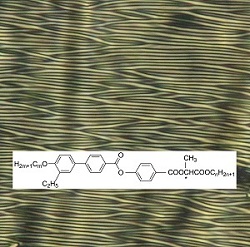
Unusual behaviour under the applied electric field for new cholesteric liquid crystals with extremely short pitch
Unusual behaviour of new cholesteric liquid crystals has been observed under applied electric field. Positive dielectric anisotropy causes reorientation of the long molecular axis along the applied electric field direction. Due to extremely short pitch length a stripe texture has been observed under applied electric field. A model based on disclinations has been proposed and anchoring energy evaluated.
New lactic acid derivatives have been prepared and studied. We have found that they form cholesteric phase with the helix pitch length in interval 120 – 200 nm within a broad temperature range. Due to the positive dielectric anisotropy and the short pitch, the applied electric field causes reversible optical changes in planar cell, due to reorientation the long molecular axis in the applied electric field and electro-optical effect was observed under polarizing microscope. Presence of short pitch and possibility to effectively affect the optical properties is promising from the point of view of specific applications. A model based on disclinationswas developed to explain the stripe texture under a sufficiently high electric field. The model also allows us to estimate the surface anchoring energy.
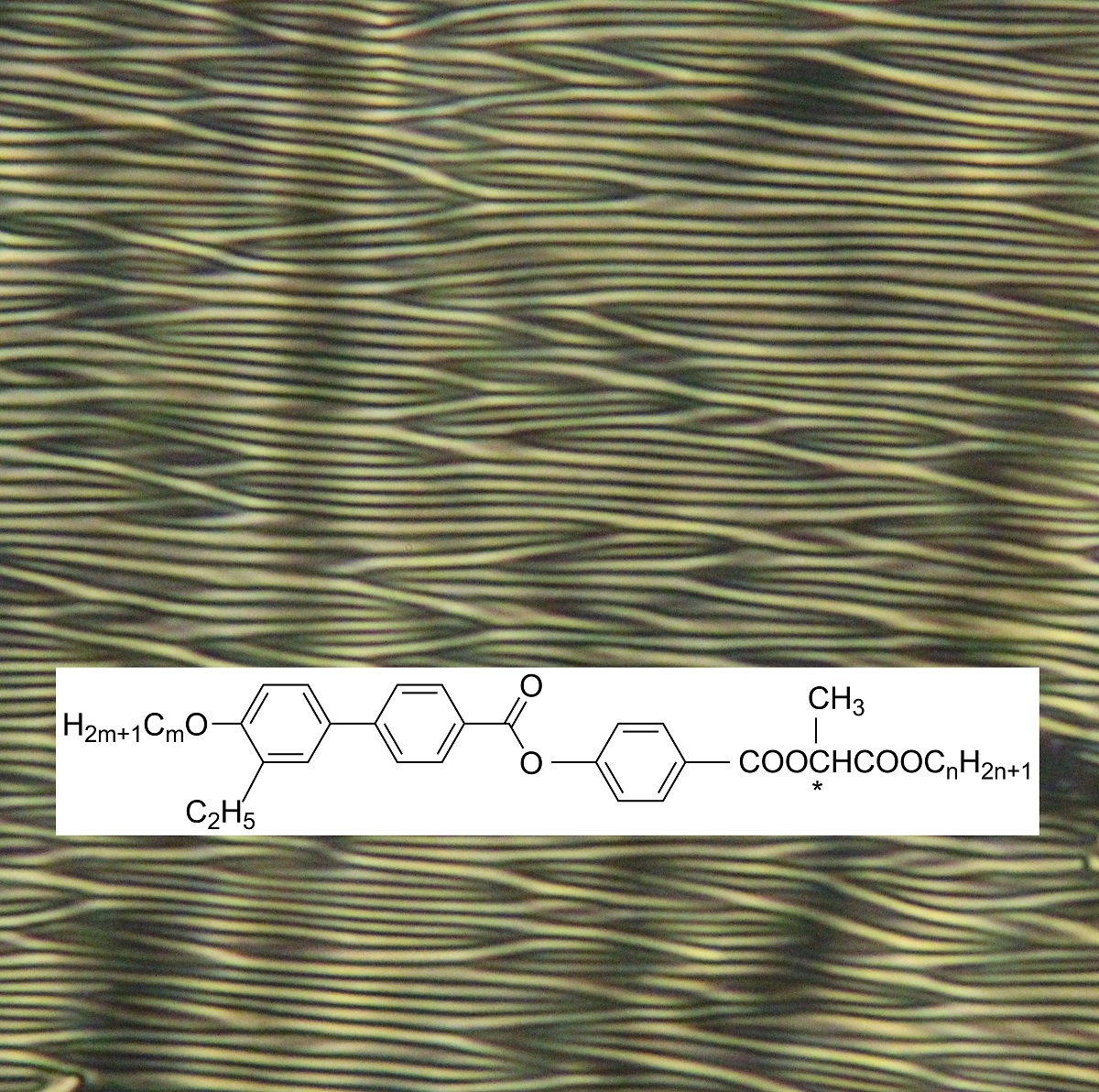
Fig. 1: Texture of the cholesteric liquid crystal in applied electric field. In the inset the chemical formula of the studied compounds is present.
[1] V. Novotná, V. Hamplová, M. Glogarová, L. Lejček, E. Gorecka, Effect of the applied electric field on new cholesterics with extremely short pitch, Liq. Cryst. 45, 634 (2018),
[2] L. Lejček, V. Novotná, M. Glogarová, A model of field induced stripe texture in the cholesterics with extremely short pitch, Liq. Cryst. 46 (2019), DOI 10.1080/02678292.1550689.
(show less)
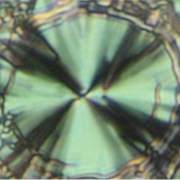
New type of dimers composed of bent-core molecules connected through their central cores
Structurally new type of dimers composed of bent-core molecules connected through their central cores has been prepared and studied. The switching behaviour in the applied electric field is reported.
We have synthesized and characterized mesomorphic behaviour of a new type of bent-core dimers in which bent-core molecules are connected core-to-core via the alkoxy chain. Interestingly, despite short linkage connecting the mesogenic cores, which should stiffen the molecular structure, the liquid crystalline properties characteristic for bent-core mesogens have been observed. Dimers are more stable in comparison with analogous monomers and the type of mesophases strictly depends on the length of the terminal chains. The shortest studied homologues formed the intercalated smectic A phase, For the dimers with intermediate terminal chains, the columnar phase appears, built of small layer fragments arranged into body centred 2-dimensional crystallographic lattice. The longest homologues exhibit the SmCP phase with antiferroelectric type of switching in the applied electric field [ M. Horčic, J. Svoboda, V. Novotná, D. Pociecha, and E. Gorecka, Chem. Commun. 53, 2721 (2017)].
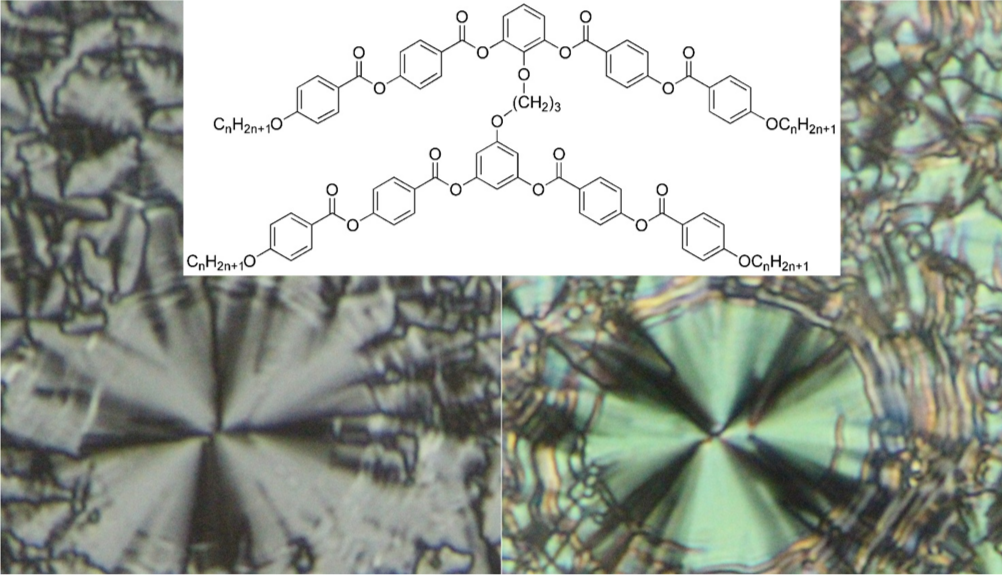
Figure: Chemical formula (top central) and electro-optical behaviour in the planar texture without applied electric field (left) and under electric field (right).

All-organic liquid crystalline radicals with a spin unit in the outer position of a bent-core system
All-organic paramagnetic liquid crystals offer the advantage of a long-range order of liquid crystalline phases and the magnetic properties of the individual molecules. In such systems, the magnetic properties can be modified by phase transition or the application of external fields. In our work paramagnetic all-organic bent-core liquid crystals having the radical-bearing unit (TEMPO) in the terminal position of an elongating side arm are studied.
The mesomorphic properties of the materials are ensured by the optimized molecular structure. The paramagnetic nature of the mesogenic materials is investigated by electron paramagnetic resonance, the magnetic properties of the bulk materials are studied by SQUID magnetometry. It is shown that the materials preserve their magnetic properties within the whole temperature range of liquid crystalline behaviour. Moreover, a strong correlation between spin orientation and molecular alignment within different mesophases has been observed [ K. Bajzıkova er al, J. Mater. Chem. C 4, 11540 (2016). ].
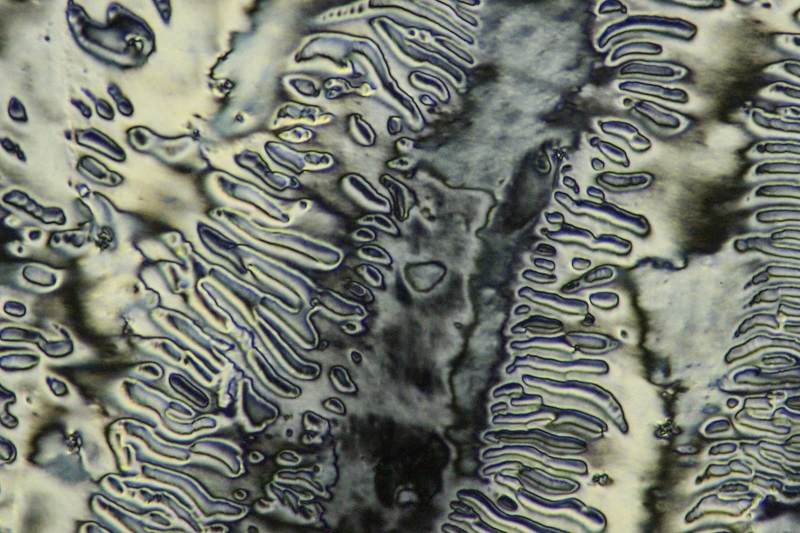
Figure: Texture in the smectic C phase for the paramagnetic liquid crystalline compound.
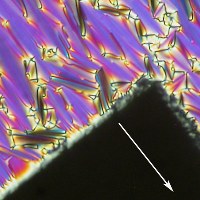
Unique effect of the electric field on a new liquid crystalline lactic acid derivative
We found a unique effect of the applied electric field for new chiral liquid crystalline compound, namely lactic acid derivative. We observed reversible transformation of the planar TGBA texture to the homeotropic one, homogeneously dark in crossed polarizers. The transformation is an analogy of the Frederiks transition known in nematics and only rarely can be found for smectics.
The unusual behavior of the TGBA phase under the electric field can be explained by the specific packing of molecules within the smectic layers, resulting in relatively high layer compressibility, which lowers the energy of structural defects and thus facilitates the structure transformation. The perfectly dark state of studied compounds, induced by the electric field, either stable or reversible, is appealing for specific applications. Positive dielectric anisotropy in both chiral compound and racemic mixture is detected up to the field frequency of about 10 kHz, above this frequency the anisotropy is negative.Such change of the dielectric anisotropysign, known in nematics as the dual frequency effect, might be important for photonics such as adaptive or diffractive optics [ V. Novotna et al., Soft Matter 11, 4649 (2015)].
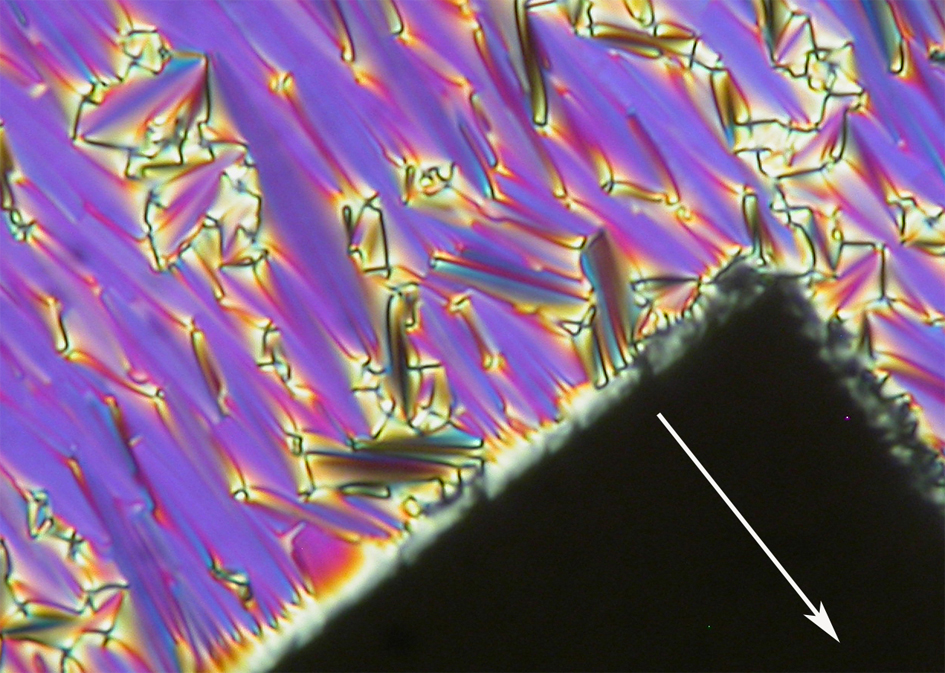
Figure: The liquid crystalline texture for the racemate of the studied compound in smectic phase after the field application: the planar texture below the electrode is transformed to homogeneous and remains homogeneously dark in crossed polarizers. The original anchoring of molecules in the planar texture is marked by a white arrow and the polarizers are parallel to the edge of the photo.
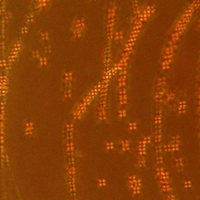
Molecular tilt induced by gold nanoparticles or clusters of nanoparticles in the liquid crystalline smectic A phase of “de Vries” type of compound
For the first time a tilt of molecules around the gold nanoparticles or their clusters has been observed in the liquid crystalline smectic A phase. We have shown the tilt is a consequence of interaction of the molecules with the surface of nanoparticle leading to a local smectic A-smectic C transition. Nanoparticles attracted to edge dislocations enable to visualize them under an optical polarizing microscope.
The observed effect proves the concept of existence of a disordered tilt in the smectic A phase of “de Vries” type [ L. Lejcek et al., Phys. Rev. E 89, 012505 (2014)].
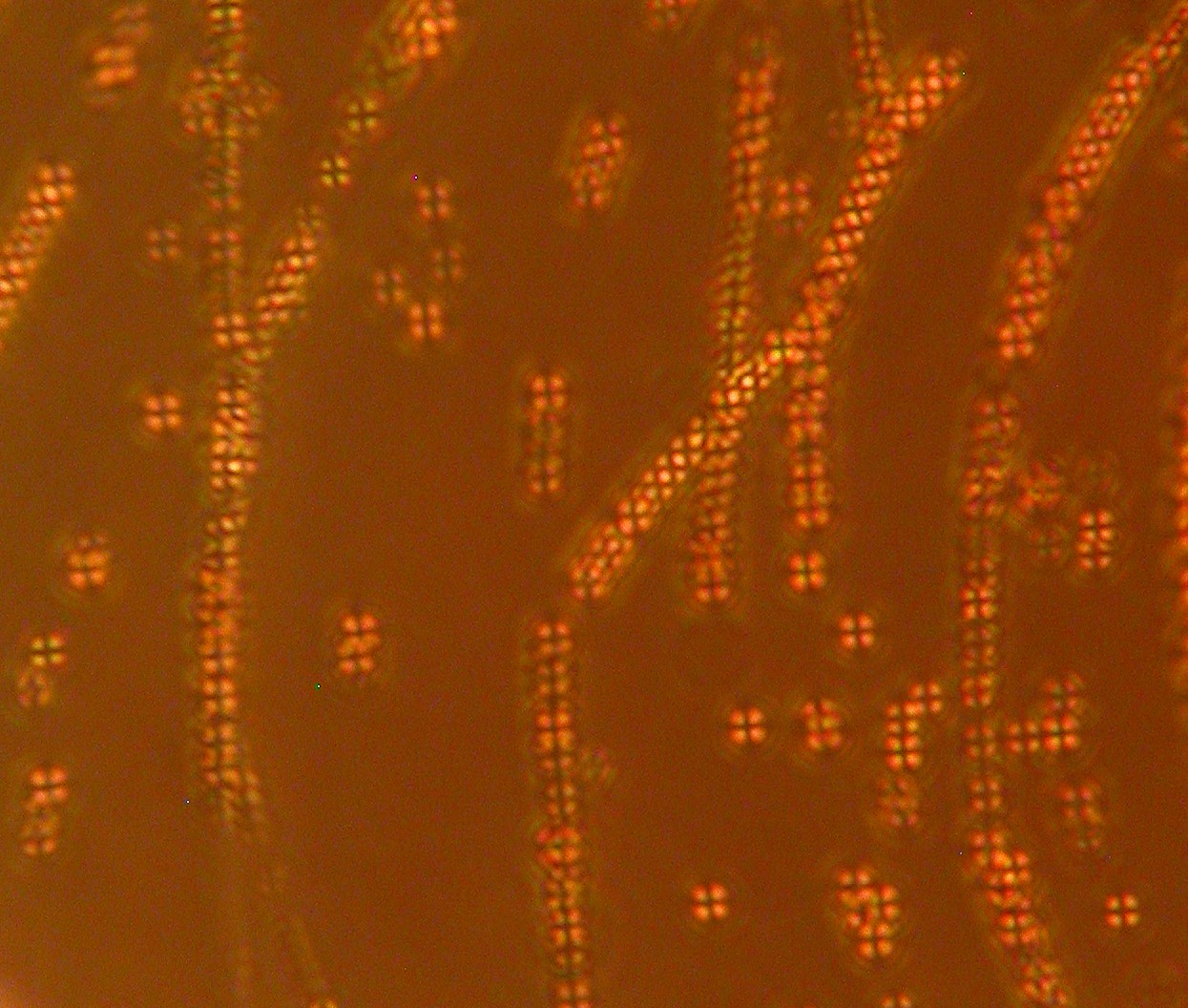
Figure: Texture in the smectic A phase observed in the polarized light for liquid crystalline compound 9HL with admixture of gold nanoparticles. Nanoparticles decorate the edge dislocations lines.
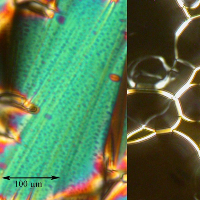
Nanocomposite of superparamagnetic maghemite nanoparticles and ferroelectric liquid crystal
We present a novel type of hybrid nanocomposite prepared by mixing maghemite nanoparticles (MNPs) and a chiral liquid crystalline compound. The multiferroic system exhibits the ferroelectricity as well as superparamagnetic (SPM) properties. The impact of nanoparticles and effect of applied magnetic field on ferroelectric liquid crystalline properties were established. The magnetic behavior is typical for a system of SPM nanoparticles with inter-particle dipolar interactions and surface spin disorder.
The unique SPM properties are preserved in the studied nanocomposite system and the magnetic response was analyzed. We established that the magnetic properties are modified due to the reduction of the dipolar interactions strength between the MNPs. Moreover, we were able to influence the ferroelectric properties by applying the magnetic field. [ V. Novotna et al., RSC Advances 3, 10919 (2013) ].
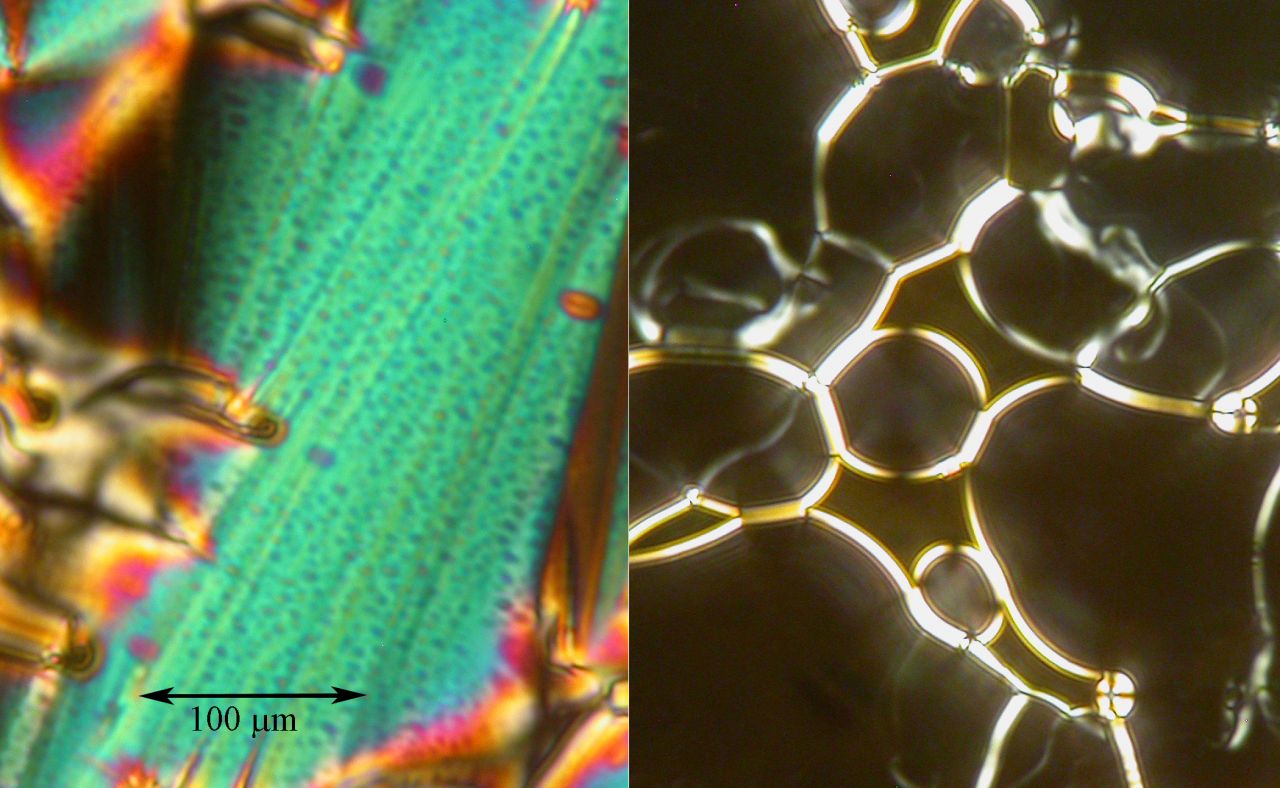
Figure 1: Texture of the smectic liquid-crystalline phase for two different nanocomposites with magnetic nanoparticles.
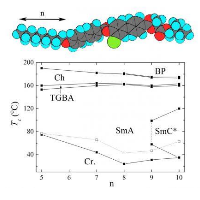
Reentrancy phenomenon of a smectic A phase in chiral liquid crystalline compounds
Unique sequence of phases was discovered in a chiral smectic, namely reentrance of orthogonal paraelectric A phase below the ferroelectric C phase. This behavior was explained by non-monotonous temperature dependence of the principal coefficient in the free energy expansion and microscopically by changes of molecular conformations and intermolecular distances due to occurrence a lateral bulky group in the molecule. This phenomenon is accompanied with anomalies in dielectric, optical and switching properties.
Stabilization of the reentrant phase was determined by mixing of the studied compound with the next homologues, which exhibit normal sequence without reentrancy. In the mixtures a direct transition between A and reentrant A phases was found, which can be understand as an analogy of crossover between liquid-like and gas-like behavior in supercritical fluids (widom-line phenomenon). The reentrant A phase can be easily influenced by electric field and exhibit strong electrooptic effect, which is promising for electrooptic application [ V. Novotná et al., Phys. Rev. E 83, 020701 (2011), N. Podoliak et al., Phys. Rev. E 84, 061704 (2011)].
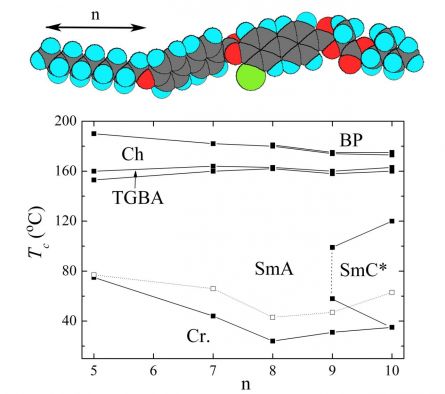
Figure: Liquid crystalline molecule of compound exhibiting reentrancy of the smectic A phase. The length of non-chiral chain is connected with the number of carbon atoms n. Phase diagram shows the homologue series of lactic acid derivatives with respect to n.

